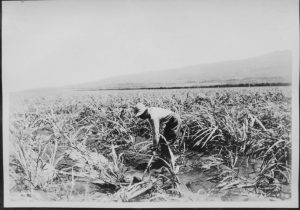Graduate Profile: Meleia Simon-Reynolds, History Doctoral Student

Meleia Simon-Reynolds is a PhD Student in the History Department at UC Santa Cruz. Her academic interests lie in the history of U.S. imperialism in the Pacific, trans-colonial labor, and modalities of representation. Simon-Reynolds is a 2020-2021 THI SSRC-DPD Fellow, Summer Research Fellow, and a participant in the National Humanities Center Graduate Student Summer Program.
THI spoke with Simon-Reynolds in August to learn more about her research and experience as a THI fellow in various capacities. We discussed the challenges and opportunities generated by interdisciplinary historical work, the significance of her research in our current moment, and the importance of pedagogical innovation.
To begin, can you give us a brief outline of what your research interests are? How would you describe your academic work?
Most broadly, I am interested in US imperialism in the Pacific, primarily the Philippines and Hawai’i. My dissertation project examines US empire by interrogating US colonial representations of trans-Pacific Filipino migrant labor. I look at visual and textual representations, specifically photographs and advertisements, that depict Filipino workers from three central places and time periods: trans-colonial plantation laborers in Hawai’i (1906-1946), agricultural and factory workers in Hawai’i and on the West Coast during the postwar period, and contemporary Overseas Filipino Workers (OFWs). Through comparative analysis, I argue that US imperial actors created visual representations of Filipino workers in order to maintain an imperial imaginary of Filipinos as docile subjects and the profitable flow of trans-Pacific labor. I also show that imperial actors utilized photographic representations to discipline Filipino bodies in response to labor activism and continued fear of anti-colonial uprising. Additionally, by highlighting the visual echoes between US representations of migrant laborers in the Pacific and present-day representations of OFWs, I aim to demonstrate that the contemporary Philippine government continues to utilize representational practices rooted in US colonialism and imperialism to advertise laborers in order to meet the demands of global capitalism. Ultimately, my analysis emphasizes that Filipino migrant workers continue to be understood as submissive workers that are subject to the control of transnational neo-colonial forces.
I aim to demonstrate that the contemporary Philippine government continues to utilize representational practices rooted in US colonialism and imperialism to advertise laborers in order to meet the demands of global capitalism.
It definitely seems like there are a lot of really interesting analytical components to your work. The ingenuity of both your methodological approach focusing on trans-colonial labor and your engagement with visual culture are really fascinating. How do you think this type of work invites historians to rethink some of the conventions of the discipline?
I hope that my focus on trans-colonial, trans-Pacific, and global Filipino labor will contribute to the recent “transnational turn” in US history, which emphasizes the movement of people, ideas, and items across international boundaries with the goal of transcending the confines of the modern nation-state. Oftentimes historical scholarship regarding Filipino migration is confined to specific time periods and geographic regions. For example, there is a lot of work on Filipino plantation labor in Hawai’i and a lot of work on Filipino migration to the US mainland, but there is not as much scholarship that analyzes Filipino labor migration across temporal and spatial zones in the Pacific. I think that my transnational perspective will allow me to tell a more holistic narrative of the Filipino migrant experience, US empire, and representational practices. Additionally, I hope that using trans-colonial labor as a framework will emphasize Filipino workers’ unique, liminal status as colonized people who migrated within the US empire as well as the transnational effects of colonial rhetoric and visual representation on Filipinos in the Philippines, Hawai‘i, and the US mainland.
My project primarily focuses on photographic representations of labor. Because of this, I use photography as a method. My project adheres to Martha Sandweiss’ recent advice that historians should consider photographs “in time,” by analyzing their context and intent as well as “through time,” by analyzing how they circulated and how interpretations of images change. This contrasts with traditional disciplinary methods that privilege written documents over visual sources. I hope that utilizing photography as a method will contribute to a growing body of scholarship that takes visual sources seriously rather than adding in photographs or other images as illustrations without critical evaluation.
This summer you have been participating in the SSRC Dissertation Proposal Development Program hosted by THI. What has your experience been like working with faculty and students in different departments? How has the program benefitted you as a scholar?

Working through the SSRC workbook and attending workshops has been one of the most generative experiences I have had in graduate school so far. Because I began the program just as I was finishing my MA, the SSRC workbook pushed me to begin thinking about how to move from my MA essay to my dissertation project in concrete and achievable ways. Because my project is interdisciplinary—I use both historical and visual studies methodologies— it has also been immensely helpful to receive feedback from folks both inside and outside of the history department. Although I was unable to go on my planned research trip due to COVID travel restrictions, I have been able to use this summer to delve deeply into relevant literature and conduct digital research.
You’ve also been both a THI Summer Research Fellow and a participant in the National Humanities Center Graduate Summer Program. How have these other forms of support allowed you to pursue your work and grow as an academic?
With support from a THI summer grant, I was able to conduct digital research in various archives with material regarding Filipino agricultural and plantation labor on the West Coast and Hawai’i and continue my Tagalog language training virtually. I was also able to devote time to preparing for my qualifying exams which I will complete at the end of the coming academic year.
The most valuable aspect of each of the THI programs I have been lucky enough to participate in is the opportunity they have given me to work collaboratively and receive feedback from graduate students and faculty from various disciplines across our campus and from other campuses throughout the country.
Participating in the National Humanities Center’s graduate student virtual residency, entitled “Passionate Teaching in the Research Environment: How to Create Meaningful Online Learning Experiences,” was also an invaluable experience for me. I am passionate about inclusive teaching and innovative teaching and have participated in various Center for Innovations in Teaching and Learning programs on campus, so it was awesome to continue my pedagogical training through the NHC program. I learned so many relevant and necessary strategies for constructing accessible, inclusive, and engaging classrooms in online environments. I am beyond excited to try out the new strategies when I TA remotely during this academic year as well as bring back the pedagogical knowledge I gained to other folks on campus. Although it was held online, the NHC program gave me access to a welcoming scholarly community of graduate students, faculty, and professionals from across the country.
Looking toward the future, what have you found particularly valuable in your experience (scholarly, interpersonally, creatively, or otherwise) this year as a THI fellow in various capacities?
Overall, the most valuable aspect of each of the THI programs I have been lucky enough to participate in is the opportunity they have given me to work collaboratively and receive feedback from graduate students and faculty from various disciplines across our campus and from other campuses throughout the country. In the past, I have felt isolated as a graduate student as I have been so focused on my own research and discipline. Building community and scholarly networks through the THI programs has been extremely helpful for my dissertation process because I intend to pursue interdisciplinary research.
